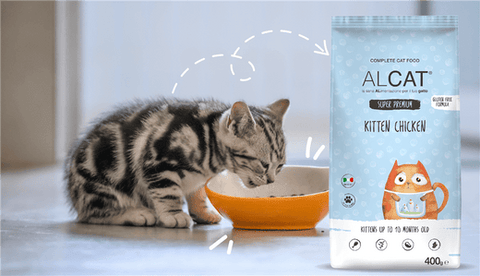Feeding a kitten: what should it eat from two months onwards?


How wonderful to find yourself holding a purring kitten in your arms! After the first moment of tenderness and cuddles, however, a rather thorny question arises: what do kittens eat? Find out in this article, along with Alcat® advice for a healthy and balanced kitten diet.
Starting from the third or fourth week after giving birth, the mother cat begins to produce less and less milk: it is in this period that weaning begins and that we can begin to introduce the kittens to solid food in order to satisfy their daily needs.
In the first months, kittens have a very small and delicate stomach, so we must pay absolute attention to the food we give them: in fact, their correct physical development in the first twelve months of life depends on it. It is therefore necessary that the food contains:
Have you recently got a new pet and are you unsure about the correct diet for your 2 month old cat? Don't worry, we are here to help you choose the right food based on your cat's needs and age. The plan is to maintain a balanced diet to ensure that the nutrients provide the different necessary properties in a homogeneous way.
Above all, it is essential that, starting from two months, the kitten's diet contains a lot of meat : cats, in fact, are essentially carnivorous animals and biologically need a diet with a high content of animal proteins .
Whether 2, 3 or 6 months old, a kitten needs a healthy and balanced diet. At the same time, however, there are some foods that should be absolutely avoided. Among these:
A kitten of 1–2 months should start introducing solid food into its diet. It is up to us to decide, based on our lifestyle, preferences and availability of time, whether to feed it with a home-made diet or with the traditional one in wet and dry food.
The important thing is that we are careful to give him light and easily digestible food.
This growth phase is essential because the 2-month-old kitten learns to familiarize itself with the basics of its future diet : a good method is to let it taste different types of food to understand its tastes and ensure it has a healthy and balanced diet
In fact, if the cat gets used to different types of food since it is a kitten, once it is an adult or elderly it will be easier for it to change its diet in case of health problems or particular nutritional needs.
When a kitten reaches 3 months, it is ready to complete weaning and move exclusively to solid food. However, it is always advisable to consult your veterinarian to get the right support in adopting the most suitable diet for your little friend.
These cat biscuits are made especially for newborn kittens.
At this stage, the kitten is in full growth and needs a lot of energy and all the nutrients necessary for healthy development. Therefore, it is important that the diet of a 3 month old kitten is rich in:
The consistency of the food is another important factor as it must adapt to the baby's teeth, which are still weak and developing.
The diet of a 4 month old kitten must still be light because the kitten still has a delicate stomach that leads him to prefer small frequent meals . It is better to divide the daily ration into several rations per day.
As the weeks go by, we slowly increase the portions of solid food in larger pieces.
A 6-month-old cat's diet should include at least three main meals , one in the evening and one in the morning, with the daily portions gradually increasing until the first year of life.
Furthermore, always keeping in mind the energy intake actually needed, we can integrate into the diet of the six-month-old kitten some snacks based on kibble throughout the day.
When the cat reaches its first year, it is already an adult : we can therefore introduce new foods or new types of dry cat food , adapting the portion and frequency of meals to its specific needs.
The kitten's diet must be carefully calibrated to support its growth, both in terms of meal frequency and quantity in grams. In the first months of life, a kitten requires several meals a day, with portions appropriate to its age.
For example, a 3-month-old kitten should consume about 200 calories per day, equal to about 50 grams of kibble, while the quantity gradually increases as it grows. From the eighth month onwards, the number of meals decreases and the quantity of kibble per meal stabilizes between 40 and 60 grams.
Here is a summary table to better understand the nutrition of the kitten cat:

Now that we have seen what is the best diet for your kitten based on its age, it is important to understand how many times a day it should eat and how consistent each portion of food should be.
Obviously, the doses of food also vary according to the kitten's development stage:
Do you have any further questions about how much a kitten or adult cat should eat? Don't worry, managing a feline's diet is much less easy than it seems: as we mentioned, there are many factors to consider and they depend on the health of your pet. Contact us for any questions: we are always available to help you and your feline friend reach the top of their game, without giving up some good food!
Kittens and their diet can be a headache both because up to a year old kittens have a delicate digestive system and because the food must be light, high-quality and balanced.
Among the Alcat® kitten cat croquettes , our Kitten Chicken represent a perfect example of complete food for kittens, in fact they are: